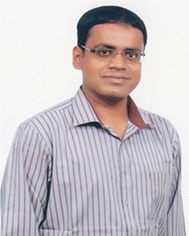Journal of Materials Chemistry A Editor’s choice collection: Advancing electrocatalysts for a sustainable world
Subrata
Kundu
CSIR-Central Electrochemical Research Institute, India
This Editor’s choice collection has been curated by Dr Subrata Kundu, Associate Editor of Journal of Materials Chemistry A, with a focus on promoting sustainability in the quest to develop a robust electrocatalyst for the future.
Experimental findings in designing effective electrocatalysts has indeed formed attractive research in a very interesting area. Production of hydrogen from water electrolysis by means of electricity or combined photon energy application, electrosynthesis of various carbon-based value-added products and ammonia synthesis from nitrate or nitrogen reduction could help to mitigate the possible hazardous effects of greenhouse gases in the atmosphere.1 The fruitful propagation of such electrochemical reactions involves designing suitable electrocatalysts with strategically modified electronic properties.2,3 In order to showcase the developments of recent advanced electrocatalysts, this collection highlights the recent experimental and review papers published on this topic.
The reviews ‘Plasmonic hot-electron assisted phase transformation in 2D-MoS2 for the hydrogen evolution reaction: current status and future prospects’ by Das et al. (https://doi.org/10.1039/d1ta10918a) and ‘Recent advances in highly active nanostructured NiFe LDH catalyst for electrochemical water splitting’ by Dhawale et al. (https://doi.org/10.1039/d0ta10712c) from India highlight the recent advancement of 2D materials used for hydrogen production via water splitting. Roy et al. from India reported the possible reasons for the activity enhancement and selectivity in sea water electrolysis (https://doi.org/10.1039/d0ta08709b). Amiri and Shahbazian-Yassar reported the recent advancement in high entropy materials for energy storage and conversion (https://doi.org/10.1039/d0ta09578h). Angnes and Gonçalves et al. portray the recent progress of highly porous MOF-derived materials for water splitting and energy storage applications (https://doi.org/10.1039/d1ta05927k). Another interesting report by Song et al. highlights the detailed journey of iron-based electrocatalysts for nitrogen reduction reaction (https://doi.org/10.1039/d3ta01548c). This present collection is not limited to these reports as there are several other reports that showcase the advancement of electrocatalysts in various other applications.
This collection also covers several other experimental findings from around the globe. Nagaiah et al. from India report the ‘Self-powered NH3 synthesis by trifunctional Co2B-based high power density Zn–air batteries’ (https://doi.org/10.1039/d3ta02178e). John et al. showcase the enhanced CO tolerance of the Ni3+-rich Ni2O3 catalyst for urea oxidation reaction (https://doi.org/10.1039/d1ta05753g). Abdinejad and Burdyny et al. report the ‘Immobilization strategies for porphyrin-based molecular catalysts for the electroreduction of CO2’ (https://doi.org/10.1039/d2ta00876a). Bedford et al. systematically investigated the ‘Identification of catalytic activity descriptors for selective 5-hydroxymethyl furfural electrooxidation to 2,5-furandicarboxylic acid’ (https://doi.org/10.1039/d2ta08306j). Liu, Gao and Chu et al. highlight the specific role of phase separated heterostructure materials for efficient hydrogen production via the methanol oxidation reaction (https://doi.org/10.1039/d2ta02955c). The report by Park et al. demonstrates the Co and Sn co-doped Ni3S2 over nickel foam for water oxidation reaction where they show a unique strategy to increase the activity by tailoring the electronic structure of doped and host metal ions (https://doi.org/10.1039/d2ta09361h). The work by Lee and Kim et al. features machine learning screening of transition metal single atom-based hydrogen evolution electrocatalysts that provides a fundamental understanding on the rational design of effective electrocatalysts (https://doi.org/10.1039/d1ta09878k). Mullins et al. report a Ni–S–P–O thin film over nickel foam with enhanced mass transport for water splitting applications (https://doi.org/10.1039/d0ta12097a). Kundu et al. provide a facile synthesis approach for NiMoO4 nanomaterials under microwave heating over nickel foam for total water splitting applications (https://doi.org/10.1039/d1ta02165f). Apart from the various articles and reviews discussed, one important perspective article by Anantharaj and Noda where the ‘significance of iR compensation in electrocatalysis’ is re-visited, will certainly be helpful for the research communities working on similar topics (https://doi.org/10.1039/D2TA01393B).
These are just the few examples of important works recently published. There are several other important works included in this Journal of Materials Chemistry A collection which demonstrate the direct and indirect goals to produce low cost and robust electrocatalysts for a better and sustainable world.
References
- J. O. M. Bockris, Int. J. Hydrogen Energy, 2002, 27, 731–740 CrossRef CAS.
- Y. Shi and B. Zhang, Chem. Soc. Rev., 2016, 45, 1529–1541 RSC.
- S. Anantharaj, S. R. Ede, K. Karthick, S. Sam Sankar, K. Sangeetha, P. E. Karthik and S. Kundu, Energy Environ. Sci., 2018, 11, 744–771 RSC.
| This journal is © The Royal Society of Chemistry 2023 |

